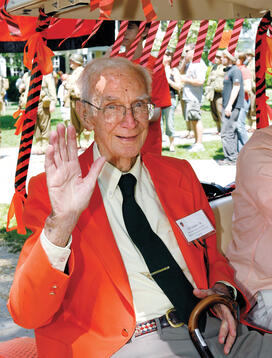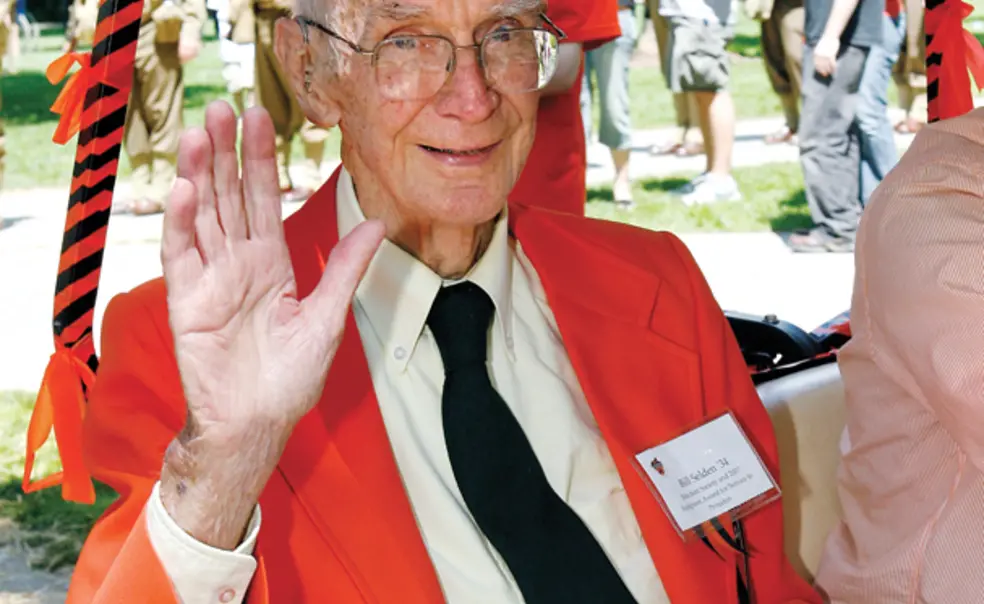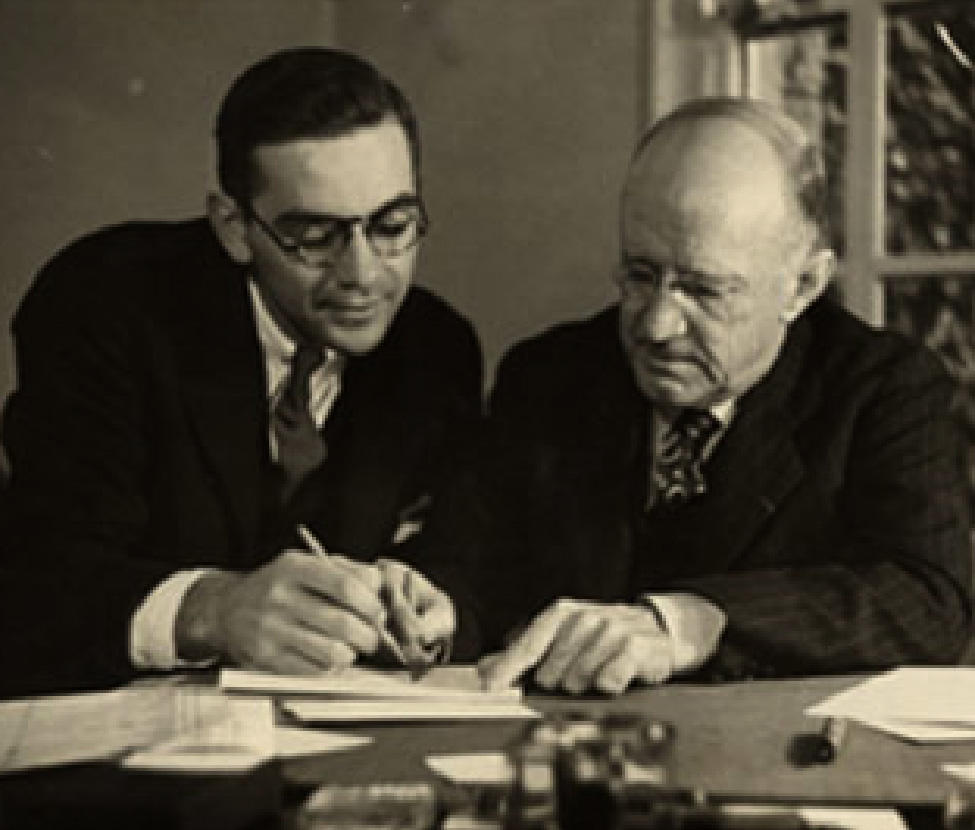A Model of Propriety
Bill Selden ’34: Friend to countless Tigers and chronicler of Princetoniana

There were many, many things to admire in Bill Selden ’34, who died late last year at a sprightly 97 years old, still with a smile and grand worldview. In a pinch, I guess my favorite was his equanimity.
We from the ’60s aren’t usually big on dispassion; far more of us tend to be in the camps of Steve Forbes ’70 or Ralph Nader ’55 than fall into any space midway between them. Whether he met either one I have no idea, but Selden would have gotten along swimmingly with either, and have had a good time doing it. That’s a fine trait, not helpful in a cable-news world but something to be treasured in a historian or a friend.
And he was a friend to every Princetonian, believe you me. In a distinctive two-part career, he gave solace and direction to students in the midst of the Depression and the accumulated wisdom of centuries to their grandchildren in the Great Recession. While this was more a minor miracle than any deft trick on his part, we need to be grateful for our good fortune and treasure his substantial legacy.
And substantial it is: books on a wondrous range of Princetoniana done over his last 25 years – on Alexander Hall, all of Princeton’s chapels (including Alexander Hall), the early years of the Woodrow Wilson School, John Cleve Green (“who?” you ask), Nassau Hall, the women of Princeton before 1969, the Nassau Club, honorary-degree recipients, Prospect House, Princeton Reunions, and all kinds of other juicy things you always wanted to know but never knew you did.
And all this was a second career, at least chronologically. There was a brief 50-year interlude during which Selden was a renowned authority on the superstructure of higher education. This began with a friendly invitation from Dean of the College Christian Gauss (who, for the sake of historical context, had been one of Woodrow Wilson 1879’s original preceptor guys in 1905) upon Selden’s graduation in 1934 to be his assistant dean for a few years. Having no other job prospects (in 1934, ya think?) and admiring Gauss, Selden took the job and applied his sense of order, seriousness, and fairness to the students who were, of course, at least one year younger than himself. In no time, he had his own verse in “The Faculty Song”:
Selden tries so hard to be
A model of propriety
A perfect dean with ne’er a vice
Whose sweet “good-bye” is just too nice.
In its usual pithy way, the song was spot on, and Selden’s very proper career progressed with stops at Brown and Northwestern, the presidency of Illinois College, then senior posts with accrediting and policy bodies that brought him back to Princeton Borough in 1965. He conducted educational studies everywhere from India to Trenton, while serving as a borough councilman and the founding president of the Princeton Arts Council. He wrote dozens of articles and studies in his field, and volunteered for dozens more good causes.
In the early ’80s, the folks at the Woodrow Wilson School wanted to commission a historical study of the school’s beginnings in 1930. Back in the day, Selden had been among the first of the SPIA majors and his thesis adviser had been Harold Dodds *14, the first chairman of the school and, in 1933, the new president of Princeton. Combining this with Selden’s track record with Gauss in the ’30s and his broad range of publications, they thought he’d be perfect for the history gig. It was a “Faculty Song” moment.
Thus began Selden’s inspired Princeton writings. While it’s impossible to sense the breadth without digging through the Archives’ Class of 1935 Princetoniana room, the calm sense of his insight readily can be gleaned from his precise description of highly emotional topics:
· On Reunions: “Princeton P-rades, which may extend for three hours, might impress the uninitiated as being incongruent with the functions of a University …”
· On eating clubs: “For a constructive dialogue to be conducted and a positive rapprochement to be attained and maintained, it is necessary that all parties involved have a common point of reference.”
· On racism at Princeton : “The issue of whether or not to allow African-Americans to become students at Princeton was more intractable and not resolved until after the middle of the 20th century. By this time the Southern traditions that had pervaded the Princeton campus for two centuries had to a large extent been dissipated. During its early years, Princeton attracted a proportionally large number of its students from the Southern states. Several of the presidents of the College were from the South and, in fact, several of its presidents, possibly including Samuel Stanhope Smith [Witherspoon’s son-in-law], owned slaves. It is, therefore, not surprising that the mores of the institution comported with the Southern traditions.”
I would like to say I could write that way, at least if I had to, but I honestly doubt it. Those who can should be treasured for their clarity, and thankfully Bill Selden was. You can see and feel him here in one of his honored parallel roles – a contributor to each of Princeton’s first 69 Annual Giving campaigns. He was chairman of the Princetoniana Committee. He was given the Alumni Council’s Service Award in 2007 (at 95 years old), with this appropriately succinct notation: “ Your historical writings have given voice to many facets of the Princeton community.”
At long last, however, I stumbled across what I now think of as the Secret Selden. It comes hidden in the epilogue of the very first Princeton book Selden undertook after his Wilson School commission, the first of his own choosing and an extremely challenging task: comparing the Princetons of 1884, 1934, and 1984 on the occasion of his 50th reunion. After telling the entrancing tale with typical exactitude, he muses uncharacteristically on the results of Princeton’s rise to the upper reaches of academia over the century:
“Success in these terms carries with it concomitant responsibilities: the responsibility to avoid parochialism from specialization in research; the responsibility not to identify success too closely with authority, popularity, power, or wealth; the responsibility not to equate academic grades and test scores with character and integrity; and the responsibility to refrain from striving for more wealth than is appropriate or prudent, or can be employed conservatively and judiciously.”
Here’s a locomotive for ’34.












No responses yet